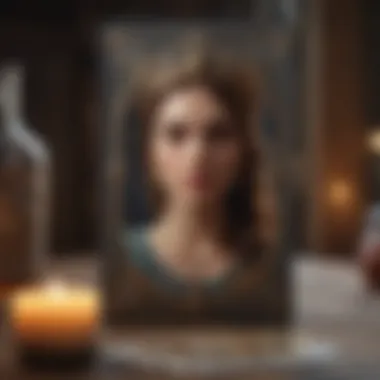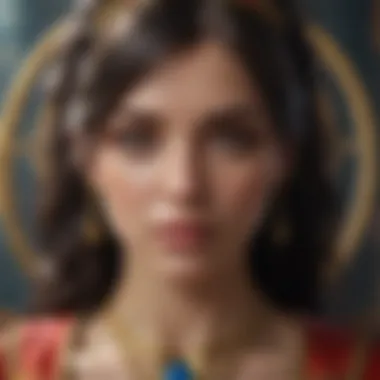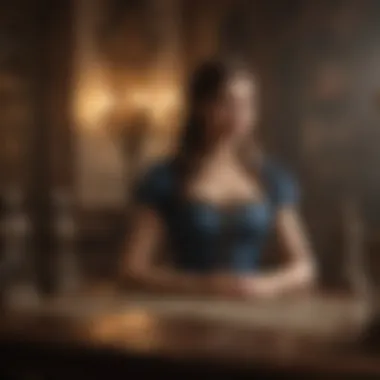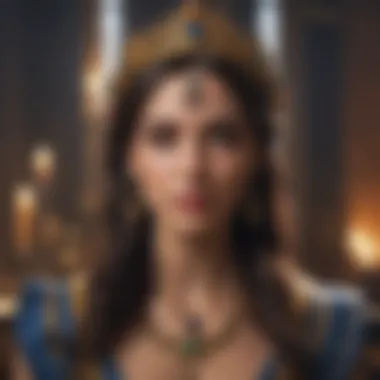Exploring the Ryder Tarot Deck: A Comprehensive Analysis


Intro
The Ryder Tarot Deck stands as a beacon of divination and introspection, deeply rooted in both history and symbolism. This article aims to dissect its complex layers, providing valuable insights into its significance in personal growth and spirituality. By understanding the intricacies of the Ryder Tarot Deck, readers can better appreciate its applications in modern life.
In this article, we will explore various aspects, including the history of the deck, its symbolic meanings, and how it can aid in self-discovery and astrological practices. Understanding these elements allows for a more profound engagement with the deck and enhances its practical uses in daily life.
Zodiac Sign Overview
General Traits and Characteristics
The Zodiac signs offer a delineation of various personality traits and behaviors that are often reflected in the interpretations within the Ryder Tarot Deck. Each sign carries unique characteristics that can influence one's approach to tarot readings and self-analysis. For instance, Aries is known for its assertiveness, while Pisces embodies sensitivity. Recognizing these traits provides a richer context for understanding the cards.
Elemental Associations
Each Zodiac sign is associated with one of the four classical elements: Fire, Earth, Air, and Water. This elemental aspect adds another layer to the meaning of the cards when they appear in readings. Fire signs, such as Leo and Sagittarius, are often connected with passion and energy, while Earth signs like Taurus and Virgo emphasize stability and practicality. Water signs reflect emotions and intuition, and Air signs are associated with intellect and communication.
Ruling Planets
The ruling planets of the Zodiac signs also play a crucial role in shaping personal characteristics and tarot dynamics. For example, Mars rules Aries, infusing its traits with courage and determination. In contrast, the nurturing effects of the Moon on Cancer foster intuition and emotional depth. Understanding these celestial influences helps to interpret tarot spreads with a more nuanced perspective.
Compatibility Analysis
Relationship Dynamics with Other Zodiac Signs
Compatibility among Zodiac signs varies widely, impacting personal relationships and Tarot interpretations. Signs often share similar elements, leading to smoother interactions or differing traits that challenge individuals to grow. Knowing these dynamics helps in interpreting the cards that represent relationships.
Friendship Compatibility
Friendship compatibility is vital to fostering strong connections. Fire signs tend to beget friendships founded on enthusiasm and shared ambitions, while Water signs may find deeper emotional ties and understanding. Recognizing these patterns promotes a more harmonious interaction with the Tarot.
Family and Workplace Relationships
Family dynamics can be complicated by differing Zodiac traits. Capricorn's ambition may clash with Libra's desire for harmony. Understanding the Zodiac's input can clarify these relationships. Similarly, in the workplace, knowing the compatibility between different signs can aid in crafting more effective team dynamics.
Astrological Influences
How Current Celestial Events Affect Each Sign
Celestial events, such as retrogrades and eclipses, exert significant influences on Zodiac signs. By understanding these heavenly phenomena, readers can better grasp the meanings behind the tarot cards drawn during specific periods. For example, Venus retrograde may highlight themes of love and connection in readings.
Monthly and Weekly Influences
Every month and week brings new astrological conditions that can affect personal growth and tarot interpretations. Recognizing these cycles allows for timely readings that speak directly to the current air of experience. Drawing cards during these periods can yield more relevant insights.
Personal Growth Opportunities Through Astrology
Astrological insights present varied opportunities for personal development. By embracing the traits associated with one's Zodiac sign, individuals can cultivate strengths and address weaknesses. The Ryder Tarot Deck offers a guide for this journey, providing reflections and prompts for deeper exploration.
Understanding the intricacies of the Ryder Tarot Deck opens doors to self-discovery and growth, integrating astrological insights for a richer experience.
Intro to the Ryder Tarot Deck
Understanding the Ryder Tarot Deck is a crucial step for anyone interested in tarot reading and its applications. This deck serves as a bridge between the subconscious and conscious realms, offering insights that can aid in personal growth and self-awareness. The Ryder Tarot Deck, known for its rich symbolism, contains keys to unlocking deeper understanding of human experiences.
Definition and Purpose


The Ryder Tarot Deck is primarily a divination tool, used to gain insight into various aspects of life. Its purpose extends beyond mere fortune-telling; it also facilitates introspection. Many users find that engaging with the cards enables them to confront personal challenges and explore unresolved feelings. The visual imagery on each card helps illustrate the complexities of human emotions and situations, making it a valuable resource for both beginners and seasoned readers.
Overview of Tarot and Its History
The history of tarot spans several centuries, originating in Europe during the 15th century. Initially, tarot cards were used for playing games before evolving into tools for divination. The adoption of tarot for spiritual purposes can be traced back to the late 18th century, when scholars began to publish works linking tarot to ancient mystical traditions. By the 20th century, the tarot reached a wider audience, particularly with the introduction of the Ryder-Waite deck in 1909 by Arthur Edward Waite and illustrator Pamela Colman Smith. This deck became a cornerstone in modern tarot, influencing countless other decks that followed. Its historical significance lies in how it shaped perceptions of tarot, emphasizing its potential for personal insight and spiritual guidance.
Historical Context of the Ryder Tarot Deck
Understanding the historical context of the Ryder Tarot Deck is crucial. It provides a framework for appreciating the development and significance of tarot as a tool for divination and self-reflection. The deck reflects a rich tapestry of cultural, spiritual, and philosophical influences that shape its meanings and applications today. By examining the origins and evolution of the deck, along with its cultural influences, one gains insights into how tarot has been integrated into various practices over the centuries.
Origins and Evolution
The origins of the Ryder Tarot Deck can be traced back to the 15th century when tarot cards first emerged in Europe. Initially, these cards served as a game rather than a divinatory tool. The concept of using tarot for divination began to take shape much later, around the 18th century. Various versions and interpretations of tarot gained popularity, each contributing to the development of the Ryder Tarot Deck.
In the early 20th century, Arthur Edward Waite commissioned artist Pamela Colman Smith to illustrate the deck that is now known as the Ryder-Waite Tarot. This collaboration became an influential milestone. The imagery and symbolism present in this deck marked a significant departure from earlier designs, establishing a framework that many contemporary decks still follow. The evolution from mere playing cards to a profound instrument of introspection illustrates a significant shift in human understanding of the self and the cosmos.
Cultural Influences on Tarot Development
Cultural influences have played a pivotal role in the evolution of tarot decks, including the Ryder Tarot. Across different epochs and regions, socio-political and religious factors contributed to how tarot was perceived and utilized.
- Esoteric Traditions: The integration of esoteric philosophies, such as Kabbalah and Hermeticism, shaped the meanings associated with the Major Arcana and the Minor Arcana. This spiritual dimension elevates the deck beyond mere cards, linking it to greater systems of knowledge.
- Art Movements: The aesthetics of the Ryder Tarot Deck also reflect the artistic movements of its time. The early 20th century was a period of profound artistic experimentation, influencing the visual language of the tarot. Pamela Colman Smith's artistic style encapsulated the mystical undertones prevalent in society, making the cards visually compelling and rich in symbolism.
- Psychological Interpretations: With the rise of Psychology in the 20th century, tarot began to be associated with personal reflection and development. The deck started being used as a tool for uncovering psychological insights, which added another layer of depth to its interpretation.
The Ryder Tarot Deck remains a dynamic cultural artifact. Its historical roots provide context for the diverse practices seen in tarot today. Understanding this context offers more profound insights into its importance for both personal growth and collective spiritual exploration.
Components of the Ryder Tarot Deck
The components of the Ryder Tarot Deck form the foundation of its use and interpretation. This segment dives into the two primary categories of cards: the Major Arcana and the Minor Arcana. Each card carries unique meanings and symbolism that contribute to the overall insights offered by the deck. Understanding these components is essential for both novice and seasoned readers, enhancing their ability to interpret the cards accurately.
Major Arcana Cards
The Major Arcana comprises twenty-two cards, each representing significant life themes and lessons. These cards hold deeper meanings compared to the Minor Arcana and often reflect major life events or spiritual lessons. They serve as key indicators during a reading, signaling pivotal moments in the querent's journey.
A common misconception is that each Major Arcana card only signifies positive outcomes. In reality, they can depict challenges and lessons that require attention. This aspect makes the Major Arcana a crucial focus for those seeking understanding of their life paths, challenges, and spiritual progression.
Minor Arcana Cards
The Minor Arcana consists of fifty-six cards divided into four suits. These suits are Cups, Pentacles, Swords, and Wands. Each suit represents different areas of life and emotions, allowing for a nuanced approach to readings.
Suit of Cups
The Suit of Cups symbolizes emotions, relationships, and connections. It highlights feelings, intimacy, and how individuals relate to one another. A key characteristic of this suit is its focus on emotional depth. The Cups are regarded as beneficial for understanding one's inner workings and interpersonal dynamics.
A unique feature of the Suit of Cups is its connection to intuition and creativity. Readers often find that this suit encourages exploration of emotional health and inner desires. The advantage of using Cups in readings is their ability to illuminate underlying emotional currents, though one must be cautious of becoming overwhelmed by emotion.
Suit of Pentacles
The Suit of Pentacles represents the material world, finances, and practical matters. This suit focuses on resources, stability, and the tangible aspects of life. Its key characteristic is the link to prosperity and growth. Being grounded, the Pentacles serve as beneficial cards for discussing career and financial insights.
A unique aspect of this suit is its emphasis on slow, steady growth. Readers may find that Pentacles encourage patience in pursuit of success. However, an overemphasis can lead to material obsession, distracting from spiritual or emotional growth.
Suit of Swords
The Suit of Swords denotes thoughts, conflict, and challenges. It often indicates intellectual engagement or disputes. One key attribute of this suit is the focus on clarity and truth. Readers frequently turn to Swords for insight into difficult situations and decision-making.
A unique feature is the symbolic representation of struggle. While Swords are beneficial for addressing conflict, they can also evoke feelings of anxiety or fear. Readers should navigate Swords with care, ensuring they focus on constructive resolutions rather than dwelling on negativity.


Suit of Wands
The Suit of Wands symbolizes creativity, action, and ambition. This suit represents passion and the drive to pursue one's goals. A key characteristic is its association with inspiration and the initiation of projects. Therefore, Wands are seen as favorable when discussing career and personal aspirations.
The unique feature of this suit is its connection to spontaneous action. It encourages readers to explore new ideas and ventures. However, one must be mindful of impulsivity, as Wands can lead to rash decisions if not adequately tempered.
Understanding these components provides essential clarity in readings, allowing for a fuller interpretation that encompasses both emotional and practical aspects of an individual's life.
Symbolism in the Ryder Tarot Deck
Symbolism plays a crucial role in understanding the Ryder Tarot Deck as it connects the cards to deeper meanings and interpretations. Each card incorporates various symbols that convey emotions, lessons, and experiences. By examining these elements, readers can gain insights into their own lives and situations. The symbolism serves as a bridge between the conscious and the subconscious, allowing for personal reflection and exploration.
Colors and Imagery
Colors and imagery in the Ryder Tarot Deck are essential to unlocking the latent meanings of the cards. Color choices often reflect specific emotions and states of being. For example, blue is frequently associated with calmness and intuition, while red may signify passion and action. The imagery throughout the deck complements these colors, promoting visual clarity and understanding.
Here are some notable aspects of color and imagery:
- Purposeful use of color: Each hue has identifiable meanings that complement the interpretations of the card.
- Iconography: The pictures on the Tarot cards are not random. Each image is carefully designed to evoke specific thoughts or meanings.
- Cultural references: Some results may draw on traditions and beliefs from various cultures, enriching the reading experience.
By interpreting the color and imagery in each card, practitioners can derive unique insights into their queries and life situations. It's essential for tarot readers to consider these elements when conducting a reading to grasp the multifaceted messages presented.
Numerology and Tarot
Numerology is another layer of symbolism found in the Ryder Tarot Deck. Each card within the deck is numbered, and these numbers hold significance that influences the card's interpretation. By recognizing the associations of certain numbers, readers can deepen their understanding of a card's meaning.
- Card grouping: Major Arcana cards, which are typically associated with significant life events, are numbered from 0 to 21. The meanings of these numbers can indicate stages of personal growth.
- Minor Arcana cards are divided into four suits and numbered from Ace to Ten, with each number reflecting a particular aspect of life.
- Patterns in readings: When numbers appear in specific patterns during readings, they can hint at trends or themes in the querent's life.
Understanding numerology contributes to an enriched reading experience. As tarot readers apply this knowledge, they can interpret messages more profoundly, leading to greater insights and guidance for personal situations and challenges.
Reading the Ryder Tarot Deck
Understanding how to read the Ryder Tarot Deck is essential for both novice and experienced users. This section focuses on the methods and techniques one can employ to effectively interpret the cards. It discusses the benefits of drawing insights from the deck and the considerations necessary for a successful reading. Tarot reading serves as a tool for introspection, guidance, and foresight in various aspects of life. Consequently, mastering it can lead to profound personal revelations.
Basic Reading Techniques
When starting with the Ryder Tarot Deck, having a grasp of basic reading techniques is crucial. These techniques lay the foundation for more in-depth analysis and interpretations. Common methods include the one-card draw, three-card spread, and various intricate layouts.
- One-Card Draw: This technique involves pulling a single card to gain immediate insight or guidance regarding a specific question or situation.
- Three-Card Spread: This method allows the reader to explore a situation's past, present, and future by drawing three cards. Each card represents an aspect of the question.
Employing these techniques helps build familiarity with the deck, increasing confidence in readings.
Understanding Card Positions
Understanding card positions is crucial to gaining comprehensive insights from readings. The arrangement of cards can change the meaning significantly, providing context to the messages drawn.
Past, Present, Future Layout
The Past, Present, Future Layout represents a popular structure that offers a straightforward approach to readings. In this layout, three cards represent different timeframes: the first card elucidates past influences, the second card reflects the present situation, and the third card indicates possible future outcomes.
This method is beneficial for readers seeking clarity in timeline-based inquiries. Its simplicity makes it accessible yet powerful. The unique feature of this layout is its ability to highlight how historical contexts shape current conditions and future possibilities. However, it may sometimes lack depth if the question requires more comprehensive examination.
Celtic Cross Spread
The Celtic Cross Spread is a more complex layout, frequently used for in-depth readings. This structure encompasses ten cards, reflecting various aspects of a situation, including influences, challenges, and possible outcomes. Each card's position tells a story, guiding the reader toward a holistic view of circumstances.


The Celtic Cross Spread is popular for its depth and detail, allowing readers to uncover layers of meaning and nuance. Its unique feature lies in its capability to address multiple facets of a question rather than providing a linear perspective. However, its complexity may intimidate beginners or lead to information overload without sufficient practice.
The Ryder Tarot Deck in Practice
The practice of using the Ryder Tarot Deck holds a deep significance for those who engage with it. This section explores how the deck serves as a valuable tool for navigating life's complexities. Whether for personal growth, understanding relationships, or gaining insights into career and finances, the Ryder Tarot Deck provides a framework for self-reflection and decision-making. Engaging with tarot can lead to profound insights, helping users confront obstacles and chart pathways forward.
Personal Growth and Self-Discovery
The Ryder Tarot Deck is particularly effective for personal growth and self-discovery. Each card embodies unique symbolism and meanings that encourage introspection. Users often find that a tarot reading reveals suppressed thoughts and feelings, unlocking new perspectives they may not have recognized before. The cards act as mirrors, reflecting internal states and guiding individuals toward emotional and spiritual maturity.
- Reflective Insights: Drawn cards stimulate contemplation of one’s life, choices, and motivations.
- Empowerment: The self-awareness gained through readings can empower individuals to take decisive actions that align with their true selves.
- Goal Setting: Understanding oneself better allows for clearer goal setting and progress tracking.
“The tarot gives you a glimpse into the subconscious mind, offering clarity where there was confusion.”
Guidance in Relationships
Another vital application of the Ryder Tarot Deck is in providing guidance for relationships. The intricacies of human connections can often be challenging to navigate. The cards can illuminate underlying dynamics, helping users understand their feelings and the perspectives of others.
- Conflict Resolution: Tarot readings can highlight sources of discord, guiding users on how to approach and resolve conflicts.
- Widening Perspectives: By assessing various aspects of a relationship through the cards, users can gain insights into how to foster healthier interactions.
Heart-centered card interpretations can lead to significantly improved communication and empathy between partners, friends, or family members.
Career and Financial Insights
The Ryder Tarot Deck also plays a crucial role in career and financial insights. Users often seek clarity on their professional lives, facing decisions or transitions. The cards provide guidance by offering perspectives on opportunities and challenges.
- Career Path Reflection: Tarot can assist in identifying suitable career paths and determining whether current roles align with personal values and aspirations.
- Financial Awareness: Readings may highlight financial habits and decisions, prompting users to reflect on their approaches to money.
Incorporating the insights from the Ryder Tarot Deck helps users create strategic plans for their professional and financial futures.
Common Misconceptions about Tarot
Understanding common misconceptions about tarot is crucial when navigating the intricate world of the Ryder Tarot Deck. Current beliefs often distort the function, significance, and efficacy of tarot readings. Clarity on these misconceptions will enhance the reader's capacity to engage with the deck meaningfully and productively. By dissecting myths, we can pave the way for more accurate and beneficial interpretations of tarot. The relevance of this discourse is not merely academic; it directly informs how individuals apply tarot in their daily lives, shaping their expectations and the utility of the cards.
Debunking Myths
Several myths surround tarot that can cloud its reputation. One significant myth is the idea that tarot readings can predict the future with absolute certainty. While tarot can provide insights and guidance, it does not function as a crystal ball. The cards reflect possibilities and emphasize personal choices rather than fated outcomes. This misunderstanding can lead to disillusionment when expected results do not manifest. Furthermore, it can diminish the reader's agency in shaping their own destiny.
Another pervasive misconception is that tarot is inherently linked to malevolent practices or occultism. Many believe that engaging with tarot invites negative energies or forces. In reality, tarot is a tool for self-reflection and empowerment, devoid of inherent moral or supernatural qualities. Many practitioners approach tarot with a desire for personal growth, clarity, and understanding, which counteracts this fear-based belief.
Additionally, some perceive tarot as only suitable for the spiritually inclined or esoteric enthusiasts. This notion limits the accessibility of tarot and overlooks its versatility as a tool for anyone seeking insight into their life circumstances. The Ryder Tarot Deck, known for its accessible imagery, serves those from various backgrounds seeking self-exploration or guidance.
Understanding the Nature of Readings
To fully comprehend tarot's potential, one must delve into the nature of readings themselves. Many newcomers to tarot enter with unclear expectations about what a reading can provide. Instead of viewing readings as concrete answers, they should be considered as dialogues between the reader, the cards, and the querent. Each session is subjective and reflects the participants' energy and current circumstances. The nature of readings emphasizes interpretation rather than prediction.
A significant aspect of this understanding is the realization that context matters. The positions of cards and the question asked influence the reading's outcome. For instance, pulling the Three of Swords in a relationship reading may signal heartache, but in a financial spread, it may indicate a need for caution. Thus, readers must develop their ability to discern varying meanings based on sequences, surrounding cards, and the querent's situation.
In summary, debunking myths and understanding the nature of readings establishes a more profound appreciation for tarot as a dynamic interpretative art. This perspective fosters an environment for personal and shared exploration through the Ryder Tarot Deck.
Closure
The analysis presented emphasizes the significance of the Ryder Tarot Deck not only as a divination tool but also as an instrument for self-discovery. Understanding its components, from the Major and Minor Arcana to the intricate symbolism within each card, allows practitioners to access deeper insights into their lives. With its rich historical context and varied applications, the Ryder Tarot Deck continues to resonate with individuals seeking clarity and guidance.
The Continuing Relevance of the Ryder Tarot Deck
Tarot's enduring popularity lies in its ability to adapt to contemporary contexts. The Ryder Tarot Deck remains a key player in this realm. As society evolves, individuals turn to the deck for personal introspection and externe guidance. Whether seeking answers about relationships, careers, or personal hurdles, the deck provides a framework for reflection. The visual and thematic elements of the cards, combined with their historical significance, create a dialogue between the reader and the universe. This relatability makes the Ryder Tarot Deck increasingly relevant as our world becomes more complex.
Final Thoughts on Tarot as a Tool
Tarot serves as a multifaceted tool for exploration. It goes beyond mere fortune-telling. Instead, it offers pathways for understanding one's emotions, thoughts, and behaviors. As practitioners become more skilled, the Ryder Tarot Deck can be used not just for personal gain but also as a means to help others. Some may consider it a spiritual guide, while others view it as a psychological tool for self-analysis. Regardless of the approach, the key takeaway is that tarot, particularly the Ryder Tarot Deck, holds the power to foster deeper human connections with oneself and with the larger universe. Its role in personal growth is profound and worth exploring for those willing to engage with it thoughtfully.



